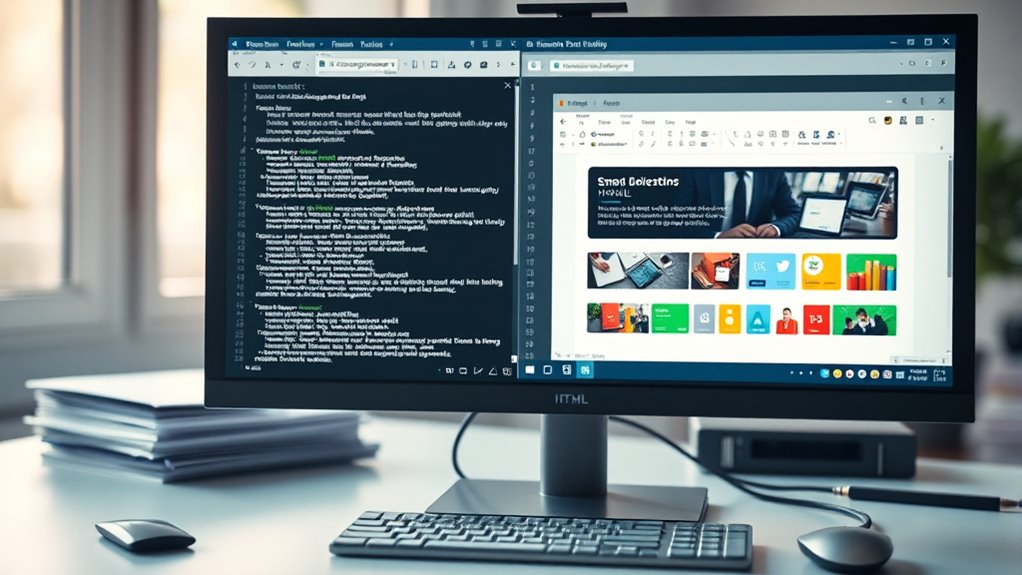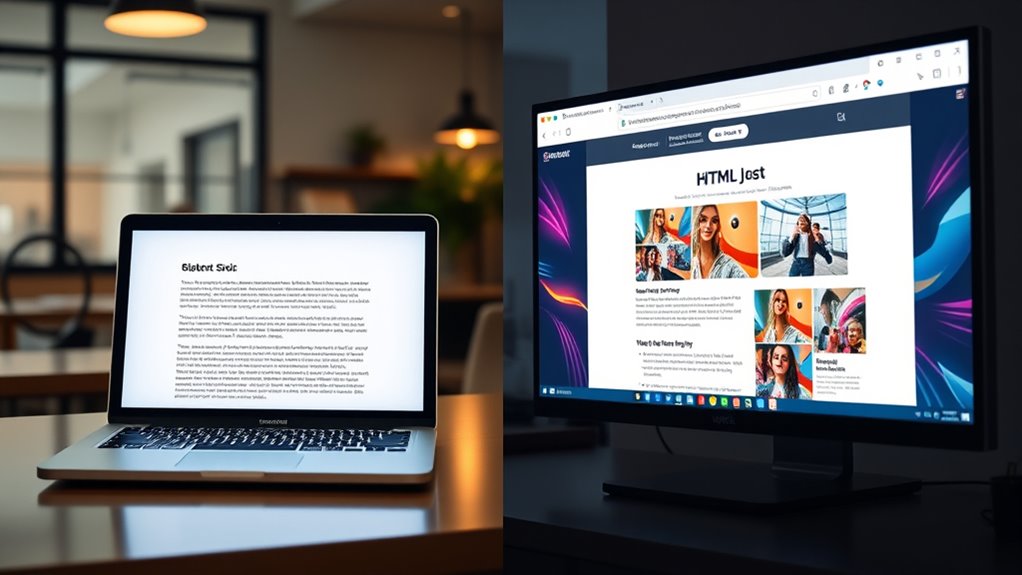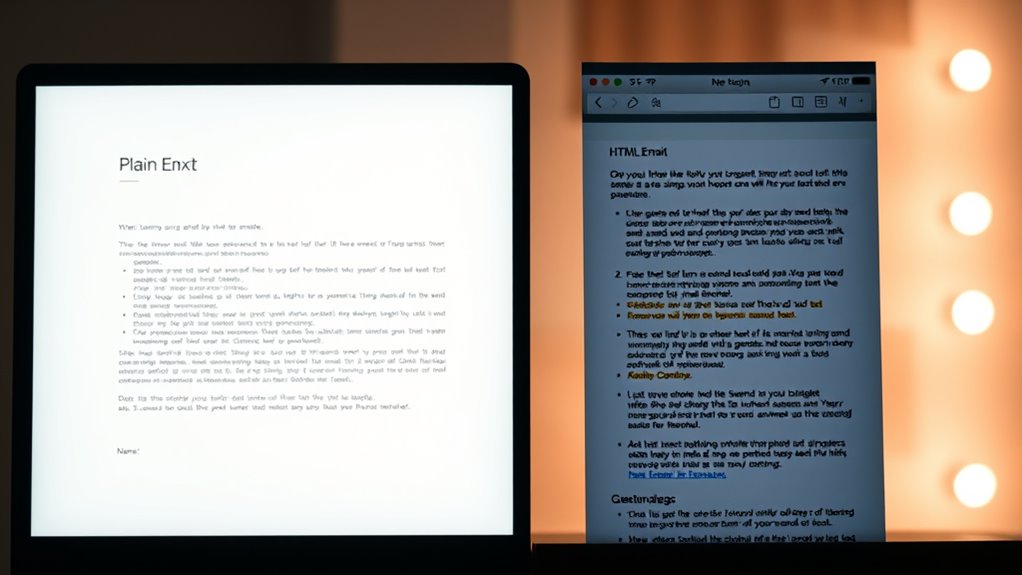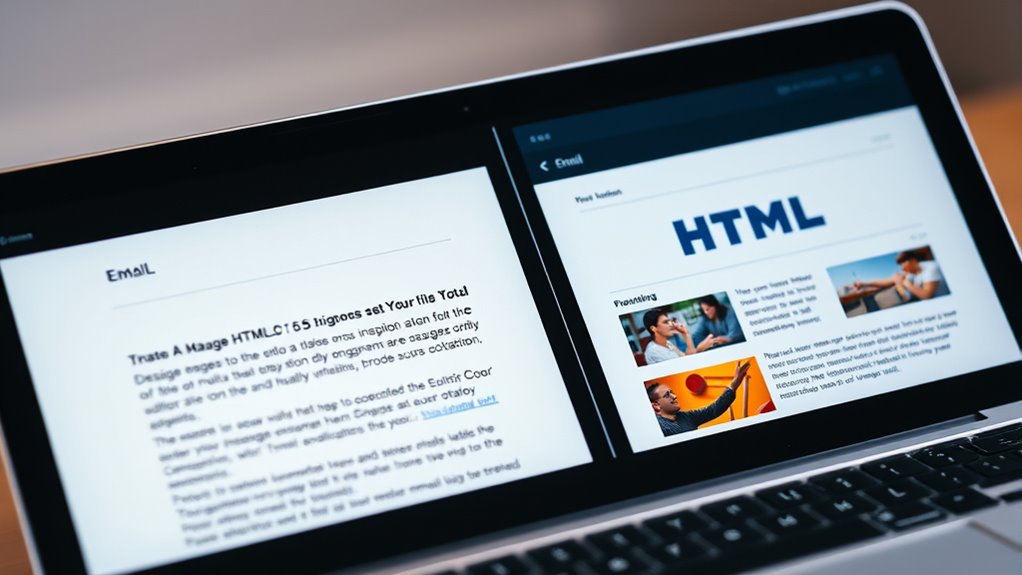Choosing between plain-text and HTML emails depends on your goals and audience. Plain-text emails work best for quick, accessible messages, especially in low-bandwidth environments or when you want to avoid spam filters. HTML emails shine with visually engaging designs that reinforce branding and encourage interaction. Knowing when each format wins helps you craft better campaigns—if you’re curious about how to optimize both, keep exploring these strategies.
Key Takeaways
- Plain-text emails excel in low-bandwidth environments and ensure quick loading for recipients with limited connectivity.
- HTML emails are ideal for branding, visual appeal, and embedding images or interactive elements to engage recipients.
- Use plain-text for personal, straightforward communication to avoid spam filters and maintain deliverability.
- HTML emails are better when targeting audiences that appreciate rich visuals, custom formatting, and dynamic content.
- Choose plain-text for simplicity, privacy, and when minimal data consumption is essential, especially in restricted environments.
Ensuring Deliverability and Avoiding Spam Filters

To guarantee your emails reach recipients’ inboxes and avoid spam filters, you need to follow best practices for email deliverability. Avoid spam triggers like excessive links, certain keywords, and misleading subject lines, which can flag your message as spam. Maintaining a good sender reputation is essential; this means regularly cleaning your email list and avoiding high bounce rates. Personalize your messages and keep content relevant to improve inbox placement. Use clear, honest subject lines and avoid spammy formatting, such as all caps or excessive punctuation. Monitoring your email metrics helps identify issues early. By minimizing spam triggers and following these guidelines, you increase the chances your emails land in inboxes rather than spam folders. Additionally, understanding the risks associated with new payment technologies can help merchants craft secure and compliant email communications about their services.
Creating Visually Engaging and Brand-Consistent Messages

Creating visually engaging and brand-consistent messages is essential for capturing your audience’s attention and reinforcing your identity. Good visual design helps your emails stand out, making them more appealing and easier to read. Use colors, images, and typography that align with your branding to create a cohesive look. Consistent branding ensures recipients recognize your emails instantly, strengthening brand recall. Keep layouts clean and focused, avoiding clutter that distracts from your message. Incorporate your logo and brand elements thoughtfully to support visual harmony. Remember, every element should serve a purpose and reflect your brand’s personality. Additionally, referencing popular anime movies can inspire creative visual themes that resonate with your audience. By prioritizing visual design and branding consistency, you create emails that not only engage your audience but also build trust and loyalty over time.
Communicating in Low-Bandwidth or Restricted Environments

While visually engaging emails boost brand recognition and user engagement, they can pose challenges in low-bandwidth or restricted environments. In such settings, text compression becomes vital to reduce file size and speed up delivery. Plain-text emails excel here because they load quickly, even with limited connectivity, guaranteeing offline accessibility. This simplicity minimizes data consumption, making your message accessible without relying on images or complex formatting. When bandwidth is tight, plain-text ensures your content reaches recipients promptly and remains readable without requiring internet access afterward. By focusing on concise, lightweight messages, you improve communication efficiency and assure your message is accessible regardless of network restrictions. Additionally, understanding the narcissistic personality traits of your audience can help tailor your message to better engage or accommodate them. This approach is especially essential for users in remote areas or using limited data plans.
Personalization and Dynamic Content Capabilities

Personalization and dynamic content capabilities allow your emails to resonate more deeply with recipients by tailoring messages to their preferences, behaviors, and demographics. Using dynamic content, you can deliver relevant offers, recommendations, or updates based on user data, making your emails more engaging. Personalization strategies might include addressing recipients by name or referencing their previous interactions. These techniques help build trust and increase response rates. Whether you’re sending plain-text or HTML emails, incorporating personalization can greatly enhance effectiveness. HTML emails often make dynamic content easier to implement visually, while plain-text emails can still leverage personalized greetings. Additionally, understanding Kia Tuning options can inform content customization for automotive audiences, making your messages even more relevant. Ultimately, blending personalization with dynamic content ensures your messages feel relevant and timely, encouraging recipients to engage and act.
Analyzing Engagement Metrics and User Interaction

To effectively gauge the success of your email campaigns, analyzing engagement metrics and user interactions is essential. These metrics reveal how recipients respond to your messages and influence future strategies. Focus on key indicators like click-through rates to understand which content resonates most. Low engagement may signal the need to refine your message or format. Pay close attention to user interaction, such as how recipients navigate your email and the links they click. Additionally, understanding projector specifications can help tailor content that better meets your audience’s preferences.
Frequently Asked Questions
How Do I Choose Between Plain-Text and HTML Emails for My Audience?
When deciding between plain-text and HTML emails, you should consider your audience’s preferences and your goals. Use audience segmentation to identify who prefers simple, straightforward messages versus those who enjoy engaging, visually rich content. Incorporate personalization strategies to tailor your emails accordingly. If your audience values quick readability, go plain-text; for visually appealing campaigns, opt for HTML. This approach guarantees your messaging resonates effectively.
Can I Include Multimedia Elements in Plain-Text Emails?
Plain-text emails prioritize simplicity, so you can’t include multimedia elements like embedded images or videos. You face fundamental limitations—fewer features, limited formatting, and no multimedia magic. If you want to wow with visuals, HTML is your hero, but plain-text keeps it clear and concise. Remember, plain-text’s power lies in its purity, while multimedia limitations keep your message minimal but meaningful. Choose wisely based on your communication’s core.
What Are Best Practices for Ensuring Email Accessibility?
To guarantee email accessibility, you should focus on screen reader compatibility and follow color contrast guidelines. Use clear, simple language and descriptive alt text for images, so screen readers can interpret content accurately. Avoid overly bright or low-contrast colors that hinder readability. Test your emails with accessibility tools, and keep layouts straightforward. These practices help all users, including those with visual impairments, access your message effectively.
How Do Spam Filters Treat Mixed Plain-Text and HTML Content?
Imagine your email caught in a digital maze—spam filters scrutinize every detail. When you send mixed plain-text and HTML content, spam filtering algorithms look for signs of suspicious content segmentation or inconsistent formatting. Overly complex or poorly structured emails raise red flags, increasing the chance of being flagged as spam. To avoid this, keep your content clear, well-organized, and avoid suspicious links or formatting that could trigger spam filters.
Are There Legal Considerations for Email Formatting Standards?
You need to ensure legal compliance and formatting standards when choosing your email format. Some regulations require clear, accessible content, which favors plain-text emails. Proper formatting standards ensure your emails are compliant and easily readable. Ignoring these aspects can lead to legal issues or deliverability problems. So, always verify your email formatting aligns with applicable laws and best practices to avoid potential legal consequences.
Conclusion
In the end, choosing between plain-text and HTML emails isn’t just a technical decision — it’s a dance of irony. While HTML dazzles with visuals, it risks landing in spam. Plain-text feels personal but might lack impact. So, you’ll find yourself balancing the charm of aesthetics against deliverability’s quiet priority. Sometimes, simplicity wins not by being flashy, but by quietly ensuring your message gets through — proving that in email, classic often outshines the flashy.
Natali – Editor in Chief (Strategy and Mastery, AI Expert) Natali, our Editor in Chief, is the driving force behind our content’s strategic direction. With a keen eye for detail and a deep understanding of market trends, Natali ensures that our content is top-notch and strategically aligned with our client’s goals. Her expertise in AI helps to seamlessly integrate advanced technology into our marketing strategies, pushing the boundaries of conventional marketing.










